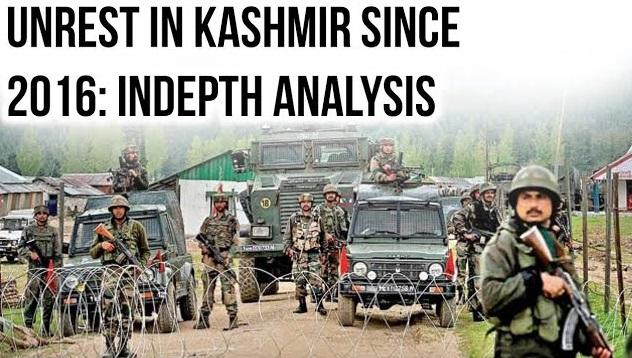Table of Contents
BACKGROUND
- In late 2015 and early 2016, observers of Kashmir reported growth in home-grown Islamic militancy and radicalization of the Kashmiri Muslim population.
- In the 2014 Indian general election, the Bharatiya Janata Party (BJP) won a majority in the Lower House of the Indian Parliament.
- Narendra Modi became the prime minister. In the state Legislative Assembly elections in the same year the Peoples Democratic Party (PDP) won a majority of the seats in the Kashmir region and the BJP won the majority of seats in the Jammu region.
BURHAN WANI
- On 8 July 2016, Burhan Wani was killed in a planned operation by the Jammu and Kashmir Police and the Rashtriya Rifles.
- The Kashmiri youth angered by the “never-ending militarization” of the Valley were drawn to him. His constant presence on social media made him a household name.
- At Wani’s funeral, an estimated 200,000 people came to mourn him, some of them from remote parts of the valley. Forty back-to-back funeral prayers were offered as well as a 21-gun salute by militants
TIMELINE
- After the news of Burhan’s death spread, protests erupted in some areas of Kashmir Valley. Curfew-like restrictions were imposed in some places in South Kashmir during the night, and internet services in many areas were suspended.
- Hurriyat chairman Syed Ali Shah Geelani and Jammu Kashmir Liberation Front chairman Yasin Malik called for a strike to protest against the killing of Wani.
- Violent clashes broke out in response to Burhan’s killing on 9 July in some areas. Over 20 police stations were attacked by mobs who stole weapons from the stations and fired upon the security forces. Stone pelting was reported from many parts of Kashmir.
TIMELINE
- By 10 July, more than 20 were confirmed to have died during the unrest. More than 300 CRPF personnel were reported to have been injured.
- On the night of 12 July, about 200–300 Kashmiri Pandit employees fled the transit camps in Kashmir due to the constant attacks by protesters.
- Over 1300 government employees belonging to the community fled the region during the unrest.Additional personnel of the Central Reserve Police Force (CRPF) meanwhile were sent to Kashmir.
TIMELINE
- On 1 August in Srinagar, protesters attacked state Education Minister Naeem Akhtar’s residence with petrol bombs.
- The unrest also started spreading to the Chenab valley region of Jammu Division in August with shutdowns being observed in many towns.
- On 5 August curfew was imposed in several places in view of the march called by separatists who were arrested. The separatists asked Kashmiris to observe a “black day” on 15 August.
TIMELINE
- On Pakistan’s Independence Day, flags of Pakistan were hoisted at many places across Kashmir and proPakistan rallies were carried out, with dozens of people reported injured when security personnel tried to disperse them.
- Curfew was lifted from all parts of Kashmir on 31 August. Curfew was reimposed on 13 September across the entire region in view of the call given by separatists for a march to the UN offices in Kashmir, while helicopters and drones were deployed to keep a watch on the situation. TIMELINE • Operation Calm Down was launched by the Indian army to restore normalcy and connectivity to regions that had been affected the most, especially in South Kashmir. The additional 4000 troops deployed were ordered to use minimal force in carrying out their duties
- On 16 November, separatists announced a full-day relaxation for two days on 19 and 20 November. This is the first such relaxation to occur since the beginning of the unrest.
- On 28 March, in a clash between security forces and protesters during an operation against a militant in Chadoora.
CASUALTIES
- More than 100 people including 2 policemen have died during the unrest Over 19,000 people including more than 15,000 civilians as well as 4,000 security personnel have been injured in the unrest.
- Indian security forces trying to control the Kashmiri agitators have used pellet guns, which, although billed as “non-lethal”, led to a high number of casualties including permanent eye injuries.
























 WhatsApp
WhatsApp